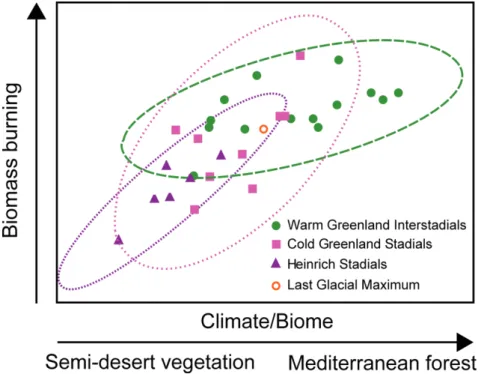PAGES MAGAZINE ∙ VOLUME 24 ∙ NO 2 ∙ DEcEMbEr 2016
79 WORKSHOP REPORT
The Global Paleofire Working Group phase 2 (GPWG2) is extending its focus to address linkages between fire and climate-driven fuel changes, traditional and modern human land- use management and biodiversity conser- vation issues. Thirty-two researchers from 11 countries with expertise in paleofire, biogeog- raphy and fire ecology, paleoclimate, expert assessment, and climate and fire modeling participated in this first meeting.
In recent years, variations in past fire activity have been mainly described by compositing fire signals geographically over large areas with heterogeneous vegetation or even climate-driven vegetation shifts. In contrast to that, the key purpose of this workshop, titled “Fire history baselines by biome”, was to reconstruct fire activity based on vegetation patterns. We identified several approaches for such comparisons and discussed concepts based on regions with an underlying homoge- neous vegetation (i.e. biomes; Fig. 1). These approaches range from testing fire vs. biome modeling to the study of fire traits, i.e. interac- tions between plants and fire that are explicitly described by a set of fire-specific plant functions. Ideas also emerged to investigate deviations from a “baseline” as past reference characteristics of a fire regime within a certain ecosystem (under stable-state conditions).
Model-data comparison based on the forth- coming FireMIP experiments offers another opportunity to better understand fire-vege- tation interactions in the Earth system. In this regard, discussions focused on Last Glacial Maximum (LGM) to present comparisons, the experimental design, and on challenges in model-data comparison. The latter point related to the reduced number of sites for LGM to compare with and the interpretation of the time series within the Global charcoal Database given as normalized trends. Such relative changes in past fire regimes limit the messages and possibilities that can be drawn out of these model-data comparisons.
Many of the discussions stressed the impor- tance of calibration studies to obtain quanti- fied and precise reconstructions of past fire regime metrics (fire size, intensity, frequency, etc.). GPWG2 launched a calibration initi- ative to build a “modern Global charcoal Database”, which will provide the possibility to analyze fire activity based on absolute num- bers and a uniform and consistent set of char- coal units. This will allow a better interpreta- tion and detailed intercomparison of charcoal records. Furthermore, upcoming model-data studies based on quantifiable variations in fire activity (i.e. fire regime metrics) will be pos- sible. During the meeting, the next steps of
this calibration endeavor were addressed and preliminary results suggest that calibration is possible when field, laboratory and analysis methods are consistent.
General statements on the risk of fires and the change of fire-danger indices in the IPcc indicate that both seem to increase under global warming. However, these indices are built upon simple assumptions rather than on detailed model analysis using dynamical vegetation–fire models including the inter- action of all feedbacks (like fuel productivity influenced by the atmospheric cO2 fertiliza- tion). To propose a better evaluation for the next IPcc report, the workshop participants designed an expert assessment survey on the likelihood of future fire regime change for dif- ferent climate-change scenarios. This assess- ment will focus on different representative concentration Pathways climate scenarios and compile the expert knowledge of model- ers, field researchers and paleo-fire experts about the most relevant factors influencing fire regime in a particular region at different timescales.
The workshop also fostered connections be- tween GPWG2 and two INQUA International Focus Groups – AcEr and FbI-HYD. The development of a chronologically harmo- nized dataset of pollen and charcoal for the last glacial period (AcEr) will allow analyses of fire-vegetation interactions in response to abrupt climate change (Fig. 1), and the cooperation with FbI-HYD, which examines fire-hydrology linkages in southern Africa, will expand the possibility of integrating the hydrological balance into vegetation-fire modeling in subtropical regions.
AcKNOWLEDGEMENTS
PAGES, PIcS cNrS 06484 project, cNrS-INSU, région Nouvelle-Aquitaine, University of bordeaux DrI and INQUA are acknowledged for workshop support.
AFFILIATIONS
1Environnements et Paléoenvironnements Océaniques et continentaux, cNrS-University of bordeaux, Pessac, France
2Helmholtz centre for Ocean research, GEOMAr, Kiel, Germany
cONTAcT
Anne-Laure Daniau: al.daniau@epoc.u-bordeaux1.fr
rEFErENcE
Daniau AL et al. (2010) PLoS ONE 5, doi: 10.1371/journal.
pone.0009157
Fire, climate and biomes –
towards a better understanding of this complex relationship
Anne-Laure Daniau
1and Tim brücher
2Global Paleofire Working Group 2 workshop, Beguey, France, 25-29 September 2016
doi: 10.22498/pages.24.2.79
Figure 1: Fire-vegetation-climate interaction during abrupt climate change of the last glacial period in the Mediterranean region (modified from Daniau et al. 2010). During cold periods (Greenland and Heinrich Stadials), the dominant vegetation was characterized by semi-desert vegetation. The fuel-limited environment restricted biomass burning activity. The increase of regional temperature and humidity at the time of warm periods (Greenland Interstadial) led to a fire regime and vegetation shift towards increased biomass burning.
